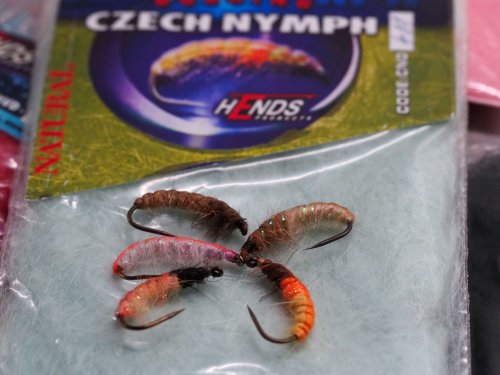What is the best dubbing material for tying classic Czech Nymphs - Bobesh? There is no clear answer to questions like this, but we can certainly look at which dubbing materials are most commonly used for tying Czech Nymphs.
The now world-famous Czech Nymphs were created in the 1990s and the original basic dubbing materials for tying these patterns were classics - hare dubbing and rabbit dubbing.
Hare dubbing is a medium coarse dubbing material - the ideal is one made from a fine underfur, but don't mind a small amount of longer guard hair which will create a leggy effect when the fly is combed.
Rabbit dubbing has always been popular because of its availability and price, plus this material is available in a really wide range of colours. Rabbit dubbing is a much finer material compared to hare dubbing.
Both of the above dubbimentioned dubbings are often made more attractive by adding synthetic dubbings or other tying materials to achieve interesting effects that can make them more attractive to fish. Popular dubbings for this use include Spectra Dubbing (a material with an iridescent sheen) and Gleamy Dubbing (a material that resembles natural seal hair in its properties) from Hends. We can also add some Holographic Dubbing (dubbing from the finest holographic foils) or Metallic Dubbing (dubbing from finely plated foils).
However, there are many more natural dubbings for tying Czech Nymphs today. Popular are dubbings made from the hair of aquatic animals - muskrats (super fine dubbing), nutria or even seals (mainly as an admixture) or even others - dubbing from possum, dubbing from American squirrel (both medium coarse dubbings) or dubbing from CDC feathers.
In addition to natural dubbings, synthetic dubbings can also be used for tying Czech Nymphs. A very fine synthetic is for example Superfine Dubbing (very fine synthetic casing again from Hends), many Czech tyers have also tied many flies with Air Fishing Dubbing from Olda Dvorak (168 colours!), but unfortunately it is no longer produced.
One of the other synthetic materials that are added to increase the effect of the fly is UV Ice Dubbing (a very fine dubbing material with a high ultraviolet iridiscent gloss). However, as with all accent dubbings, it is a good idea to be sparing with this material and only use it to accentuate the fly effect.
The last group of dubbings for tying Czech Nymphs are specially prepared mixes - often labeled as Czech Nymph Dubbing or similar. Here it can be a mix of natural materials in combination with fine underfur and coarser guard hair (e.g. rabbit and hare combination) or it can be a mix with a bit of synthetics.
As you can see, there are many materials for tying Czech Nymphs, for a start I recommend to try the classics first (rabbit, hare or special Czech Nymph mix) and then start experimenting with less common materials.
For more information on dubbing materials, I recommend our special Guide To Basic Dubbing Materials, and for complete information on the Czech nymph, the book Czech Nymph and Other Related Fly Fishing Methods by Karel Křivanec.













